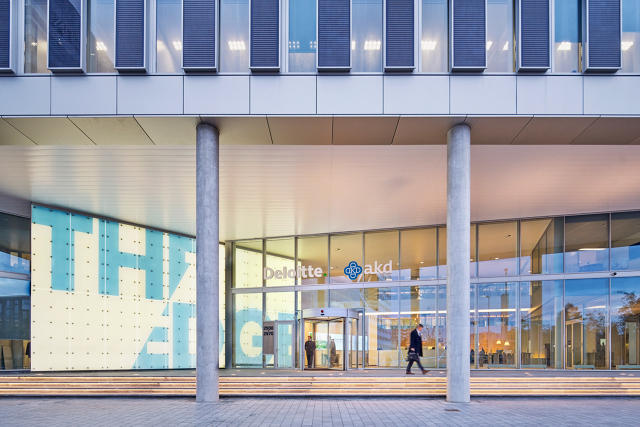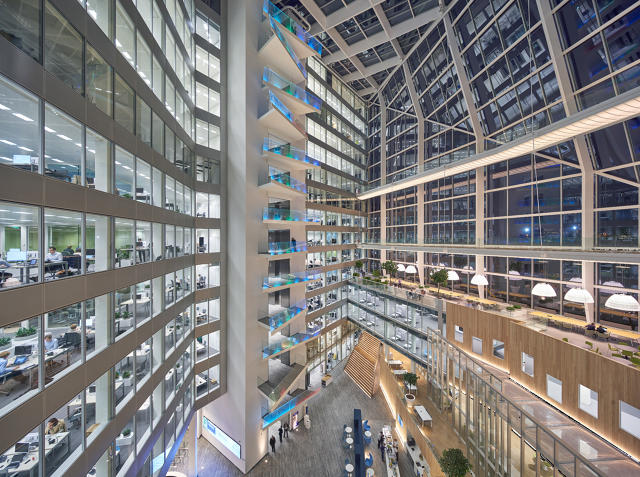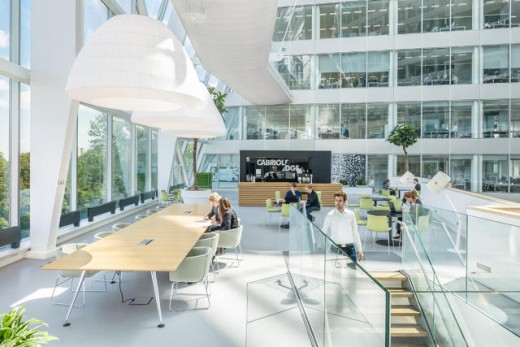This Frighteningly sensible administrative center building is aware of precisely What you wish to have, When you need It
the threshold could also be probably the most connected—and greenest—place of work any place on the earth. is that this the way forward for working?
October 21, 2015
when you pull up for work at Deloitte’s new office constructing in Amsterdam, the storage automatically acknowledges your automobile or bike, opens the gate, and courses you to a parking spot and a free electrical charger. The place of work app assigns you a desk, in response to your schedule for the day and whether you are within the temper for a standing desk or a spot to pay attention. if you begin work, you can use the app to tweak the lighting fixtures or heat until it can be just right.
Welcome to the brink, essentially the most related workplace anyplace. The building’s huge community of sensors—round forty,000—is extraordinary, however came about partly by chance.
“We were in a little bit of a contest to peer if shall we take advantage of sustainable building in the world,” says Coen van Oostrom, CEO of OVG actual estate, the building’s developer. to interrupt the report (measured via BREEAM, a U.okay. score system similar to LEED in the U.S.), they wanted so-known as “innovation credits” for making an attempt one thing new, a ways past issues like the standard solar panels and rainwater harvesting.

So, the usage of merchandise from Philips, they attached each gentle within the constructing to Ethernet cables that additionally ship Wi-Fi. “each mild has its own IP deal with,” he says. The lights can sense when space in the constructing is unoccupied, and switch down the heat to save energy. the new machine helped earn the design a document-breaking sustainability rating. (although another administrative center building, within the U.S., recently claimed the title of “greenest high rise on the planet“—on account of different score techniques, it is not clear exactly which is more sustainable.)
the brand new sensors additionally had unexpected advantages; as they feed details about mild, heat and motion again to the cloud, they are also serving to firms uncover things they’d by no means thought to be.
“With large data, we had the flexibility to completely take into account how individuals use the building,” says van Oostrom. “we are able to do things that we failed to predict once we started. A cleaning woman who works in this constructing now has a heat map on her smartphone telling her what bathrooms have been used and what bogs have not been used. there may be a complete new world of marvel coming from this connectivity that we did not uncover prior to.”
The constructing knows when the espresso laptop needs to be refilled within the damage room (the app additionally remembers how you like your espresso). Towel dispensers within the restroom track use, and ping janitors when it appears especially busy and bathrooms might need to be cleaned. The on-website online health club tracks your development throughout the app.

The app additionally connects to different services. if you are hungry at the end of the day, that you can make a choice a meal and the choice of folks you need to feed, and a paper bag with the exact quantity of substances needed can be brought to a fridge within the building’s basement.
“You choose it up there, you go residence, and within 10 minutes which you can have a superbly cooked meal with zero waste,” van Oostrom says. “you don’t want to go to the grocery retailer.”
The building’s linked methods also help store area, given that staff do not need to make use of assigned desks. “should you see a standard administrative center constructing on the earth, you will see that that these buildings are 30% to forty% empty many times in a day,” he says. by means of the usage of the app to provide employees desks handiest as wanted—a.okay.a. scorching-desking—the building can accommodate extra people in a much smaller footprint.
even if the constructing tracks everybody’s move, there are not any nefarious big Brother plans right here. A boss, as an instance, does not have get right of entry to to data about when an employee’s automotive pulled into the parking zone, or how lengthy they have been sitting at their desk. The device is not meant for particular person data assortment, but for having a look at patterns of utilization as an entire.
OVG, also based totally in the building, is using the information gathered to this point to start planning its next undertaking—an even more connected place of job. “We now see, what’s mainly coming back from all the giant data, that we can design structures even in a better manner than we have now done sooner than,” van Oostrom says. for instance, they’ve already discovered that they want even fewer desks than they initially idea.

the corporate is also planning to take sustainability even further with its next development, a mixed-used place of business and apartment building. that’s pronouncing so much, for the reason that facet is already ultra-sustainable. It uses so little vitality that it may possibly in fact produce more energy than it needs via sun panels; train bikes in the on-website gymnasium present just a little further energy when folks journey. Rainwater is used to flush toilets and water the garden. an enormous thermal storage device, drilled into the bottom below the constructing, stores water for heat within the winter. a big atrium fills the administrative center with natural gentle and offers natural ventilation.
but OVG needs to do extra. “We basically make buildings in an extraordinarily linear kind,” van Oostrom says. “we now have an architect design one thing, we construct it, we use it for 30 or forty years, after which we demolish the building again and throw away the fabric.” as a substitute, he says, structures will also be designed for the “round economy”—with materials so that it will be reused. For the next constructing, OVG will use a facade that can be rented for 30 years. Then the manufacturer will take it back and recycle it into a new one.
“that is for us mainly the remaining big step that we can take in making constructions in a way that they wouldn’t have any poor footprint on this earth anymore,” he says. “The vitality phase we solved already. the fabric section we wish to resolve subsequent. Cities sooner or later can be smart and have zero impression on society.”
Connectivity shall be part of that transition, he says, and it’ll soon be widespread. “we expect that in five or 10 years all place of business constructions on the planet shall be completely related.”
[All Photos: via OVG Real Estate]
(90)














